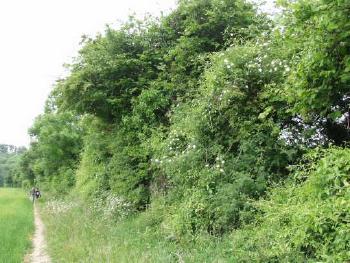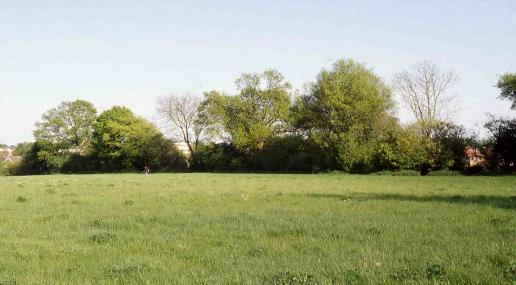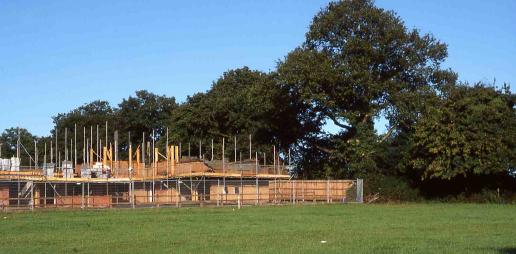





|


One of the most important and enjoyable activities in South-East Hampshire is surveying the local hedgerows.
A rich habitat for wildlife and a valuable feature of the landscape both historically and environmentally. The information on these pages aims to keep people in South-east Hampshire aware of progress with surveys and give a detailed picture of the hedgerow network in the Horndean area. We would be glad to hear from anyone that would like to join with small local groups or help (or start) a parish survey in your own area.

This is my 30th year of surveying local hedgerows. The aims and methodology have changed over the years and I have used at least six different survey forms but the overall aim is still to improve the protection and management of hedgerows in East Hampshire by raising awareness of the value for biodiversity and landscape quality.
My first surveys were carried out with a local history group in 1975 studying ancient parish boundaries and the evolution of the landscape. A main interest was in dating the hedgerows by counting the tree and shrub species in one or more 30 yard stretches and applying Dr Max Hooper's Rule that suggested that in any 30 yard stretch, each shrub species represented a 100 years. There are many reasons why this is not regarded as reliable for dating purposes today but also by using results as a rough guide to age would need to be verified by a study of old parish maps, land deeds, estate records, and other local landscape features.
 The first hedgerow surveyed by counting species and researching archives was this Ancient hedgerow with a Public Footpath alongside at Finchdean, not far from the Sussex border.
The first hedgerow surveyed by counting species and researching archives was this Ancient hedgerow with a Public Footpath alongside at Finchdean, not far from the Sussex border.
(MRef: SU 735 130 now part of the Staunton Way)
The hedge contains a high number of species and with other evidence would suggest over a thousand years old, possibly pre-Saxon. There are many hedges throughout the local parishes that are thought to be of ancient origin. We need to collect as much information now as possible to help oppose any plans to remove hedges or become lost by neglect or bad management.
In 1980 - The Tree Warden Scheme started in East Hampshire (see TWs Page) and soon after this Horndean Parish Tree Wardens carried out a detailed survey of the Hedgerow extending between Catherington and Frogmore Lanes as this was threatened by development. At that time there was no protection for hedgerows so this hedgerow was regarded as a strip of ancient woodland, even a relic of the original 'wild wood'. It had a high count of native species with bluebells and ransomes amongst the ground flora.
The EHDC ensured that this valuable feature in the landscape was retained although building work came much too close and some of the trees suffered damage. It is also a good wildlife 'corridor'. The hedgerow is still there and now acts as the Urban/Rural "frontier".
 In 1994 and then 5 years later as houses were being built - far too close to the hedgerow.
In 1994 and then 5 years later as houses were being built - far too close to the hedgerow.

In 1994 - A survey was carried out on 60 hedges in East Hampshire selected to establish the condition, management, landscape and ecological value within the E.H.D.C. area. Now 10 years later, these surveys provide a good reference to changes in condition.
In June 1997 - The Hedgerow Regulations were introduced requiring local authorities to be notified if any hedgerow over 20 metres in length is to be removed or destroyed. The council could refuse consent if the hedge was considered important according to a set of criteria - now modified as the original critera would not save many hedges.
In July 1997 - The CPRE (Council for the Protection of Rural England) launched a major campaign to encourage communities across the country to carry out surveys. Hedgerow Action Packs were produced to help local groups with guidance for local co-ordinators. Many areas did detailed surveys and the CPRE organised several seminars at their offices in London. They continued to lobby parliament for improvements to the Regulations, also extending to include field boundaries. In many counties there has been close liaison between local councils and the CPRE, Wildlife Trusts, BTCV (all of which have produced Action packs).
In June 2001 - Hampshire Wildlife Trust launched a Hampshire-wide Hedgerow Survey and for the first phase produced a simple survey form to encourage a large number of people to take part across the county. From these results it was intended to choose a selection of hedgerows for a more detailed survey but unfortunately there were not the resources or funding available to continue.
The Trust did run a number of training courses for HR Surveyors to encourage local parish surveys, back to 1997 or earlier and the BTCV were organising courses in HR management including hedgelaying. I have found all of these courses and seminars most interesting. Theygave me great encouragement to carry on with our local Horndean Parish Hedgerow Survey.
In 2002 Defra produced the Hedgerow Handbook - to provide a standard procedure for local surveys in the UK. The procedure was adopted by most survey groups after this date. It gives good guidance and is comprehensive in covering most aspect of doing hedgerow surveys although a number of modifications have been found necessary according to local conditions and requirements.
In Spring 1994 the Hampshire Hedgerow Project was launched and in the pilot phase three districts in Hampshire, Basingstoke, Fareham and East Hampshire. A Training day was held on 8 May 04 and 120 hedgerows were surveyed by 37 volunteers between May and the end of August. The standard method described in the defra Handbook was used but it was indicated in the report that the standard method would not be suitable for this project where volunteer experience varied, adjustments would be needed.
A modified system was 'tested' on a second training day on 8 May 05 to launch the second phase. It is sad to say that the Project did not get underway and so for a second time a Hampshire Hedgerow Survey has been aborted. Various reasons are given but the project involved a considerable ammount of time for Trust officers at a time when restructuring of staff had to take place. Also the project would take a lot of time for the final analysis and data processing. It is a disappointment to volunteers but I am sure they would wish to thank Dr.David Rumble and other HWT staff for the help and support they gave. And so what of the future ?
In February 2005 'defra' published a new Environmental Stewardship Scheme at three levels. All levels give benefits for the good management of hedgerows, field boundaries and trees which gain 'points' towards the level of grants. Advice and help is given by HCC (HBic), HWT, FWAG, and defra and it is encouraging to know that many farmers are taking up the offers and applying.
The Future of Hampshire Hedgerow Surveys ?
There are problems on a county-wide survey of quality control and processing data and the best way ahead now is for the project to continue at a local or parish level. Parish Surveys will provide a valuable input to Village Design Statements, Local Conservation plans, local planning committees and landowners. From these surveys a selection of important hedgerows can be fully surveyed in a way that data will be useful to HBIC and in this way will involve local communities and tap local expertise and knowledge. This particularly applies to the biodiversity. This web page will therefore be giving information on parish surveys in East Hampshire, especially Horndean and neighbouring parishes.

| The Horndean Hedgerow Survey is most grateful for the help and support received from the following organisations. |     |
| |  |
Click on the title of the sub-section you require.



Objective: To improve our knowledge and awareness of hedgerows in the Horndean area through surveys and research. Horndean is in a part of Hampshire that still retains a good network of hedgerows in a variety of types, some neglected and overgrown, others over-managed but mostly providing rich habitats for wildlife.
Threats: General neglect or inappropriate management (often over-flailed) but currently developments where housing density does not allow for the retention of natural features or wildlife corridors.
The Area being surveyed includes Blendworth, Catherington, Lovedean, parts of Finchdean and Clanfield and part of the south-east network that extends into Rowland's Castle parish all covering 30 square kilometres.
Timescale: The Horndean Hedgerow Survey started in earnest in 2002.It is now hoped to complete field surveys during 2006. Little progress was made during 2005 owing mainly to the confusion caused by trying to integrate with the County project which is not continuing. We will therefore revert to using the methods in use for the previous three years with some modifications gained from experience with the county project.
The completed survey will have taken 5 years but during this time a lot of information has been collected and now has to be collated and 'edited' into a comprehensive document.
A newsletter will be sent to all volunteers previously involved early next year and another surveyors meeting will be held in March 2006 in which full details of the programme for the year will be given. Details of all the gaps in our hedgerow survey will be entered on forms, allocated (by choice) to volunteers so that an early start can be made and the field surveys can be adjusted according to weather and volunteer's private commitments.
It is important that all the field surveys are completed by the end of October 2006 in order that the data can be processed and a draft analysis and report can be made by the end of the year.
 This picture shows a mixture of hedgerows in the north-west corner of Horndean. A numbered register of all the hedgerows in the parish that have been surveyed is now almost complete and a selection of the most important ones are shown below. This picture shows a mixture of hedgerows in the north-west corner of Horndean. A numbered register of all the hedgerows in the parish that have been surveyed is now almost complete and a selection of the most important ones are shown below.
There is also a section on Hedgerow Trees and Hedgerow Verges.
References and Web Links
In the last 30 years, since the classic book "Hedges" was published in the New naturalist series in 1974 there has bee a large number of publications on hedgerows ranging from articles and pamphlets to booklets and larger volumes over 300 pages, and they are still being published ! The latest being "Hedgerow History" 2006. I have made a selection and divided them under 4 headings, listed alphabetically by author.
1. General reading.
Angus,A (1987) Hedgerow Explores through the seasons, beautifully illustrated by Michael Woods
Appleby,M. (1998) The Hedgerow: Icon of the English Landscape CPRE Hedgerow Seminar, London
Barnes,C & Williamson,T (2006) Hedgerow History - Ecology, History & Landscape Character Windgather Press
Barr,C & Petit,S.(Eds)(2001) Hedgerows of the World, their ecological functions in different landscapes. IALE/CEH
Bennett,A.F. (ed)(1999)Linkages in the Landscape IUCN The role of Corridors and Connectivity in wildlife conservation.
Bryson,Bill (1993) Britain's Hedgerows An excellent and readable review. National Geographic, Sept.1993,94-117
Cooper,C. (1997) Hedgerows- Hedges in the Landscape Talk on HWT Hedgerow course Oct'97 -a good historical review.
Dowdeswell,C. (1997) Hedgerows and Verges Allen & Unwin
Hampshire Wildlife Trust (1996) Hedges for Wildlife Good 5-page summary
Mabey,R.(1974) The Roadside Wildlife Book David & Charles
Muir,R & Muir,N. (1987) Hedgerows - Their History and Wildlife Michael Joseph
Pollard,E.,Hooper,M & Moore,N.W. (1974) Hedges Collins,New Naturalist No.58
Rackham,O. (1986) The History of the Countryside Dent & Son
Stokes,J. & Hand,K The Hedge Tree Handbook The Tree Council
Streeter,D. & Page,R. (1982) Discovering Hedgerows BBC Publication, from TV Series in 1982.
White,J. (1980) Hedgerow All aspects, illustrated by Eric Thomas Ash & Grant
Williamson,T. (2000) Understanding EnclosureLandscape Vol1 No1,56-79 (Windgather Press)
Williamson,T. (2002) Hedges and Walls Nat Trust (Living Landscapes)
Wilson,R. (1979) The hedgerow Book David & Charles
Wolton,R. (1999) Do we need hedges anymore ? Biologist 1999 46(3) 118-122
2. Surveying and Protection
Bickmore,C.J. (2002) Hedgerow Survey Handbook Standard Procedure for local surveys in the UK - Defra
Clement,D & Tofts,R.J. (1992) Hedgerow Eavluation and Grading System (HEGS) CPM
Clement,D & Tofts,R.J. (1992) Hedges Make the Grade British Wildlife Vol.4No.2, 87-95
Cotterell,C (1997) A Guide for Local Hedgerow Co-ordinators CPRE- for use with HR Action packs.
CPRE (1997) Hedgerow Action Pack Campaign to Protect Rural England
DETR Dept.of the Environment (1997) The Hedgerow Regulations Reviews and Revisions produced 1998-00
The Wildlife Trusts, the BTCV and FWAG have produced many good leaflets and survey information over the last 10 years.
3. Identification of species.
There are numerous identification books on Trees but they do not include many of the important shrub species found in hedgerows. The best all round book at reasonable cost, now available in paperback and portable is Reader's Digest (1981) Field guide to the Trees and Shrubs of Britain reprints to date
Maclean's book listed below (New Hedges) gives good illustrations of hedgerow plants and the CPRE Hedgerow Action Pack has a good ID guide.
4. Management and care, including planting.
Andrews & Rebane,M. (1994) Farming and Wildlife Chapter 8 is on hedgerows - RSPB Handbook
Beddall,J.L.(1950) Hedges for Farm and garden. A classic with good practical guidance.Faber
Brooks,A. (1975) Hedging, a practical handbook BTCV
Defra (Rural Development Service)(2005) Environmental Stewardship-Entry Level Handbook Guide for farmers for grants (How to gain points !)
Ferguson,C. (1998) The Good Hedge Guide FWAG/Beyer
Greaves,V. (1986) Hedgelaying Explained National Hedgelaying Society
Maclean,M. (1992) New Hedges for the Counctryside Farming Press
Maclean,M. (2000) Resource Management; Hedges Farming Press - A smaller updated pbk version of the 1992 book.
Sotherton,N & Page,R. (1998) A Farmer's Guide to Hedgerow and Field margin Management Game Conservancy Trust
Thompson,P. (2001) Farming and Wildlife- conserving Hampshire countryside Hampshire Life
Watt,T.A. & Buckley,G. (1994) Hedgerow Management and Nature Conservation Wye College.
5. Regional
Archer,F. (1970) Hawthorn Hedge Country Life around Ayshon in the Vale of Evesham
Detr Dept of Environment (2000) Locally Distinctive Hedgerows
DEVON Hedgerow Group (1997) Devon's Hedgerows - Conservation and Management
Menneer,R. (1994) Wildlife Revival in Cornish Hedges Dyllansow Truran Publ.
|

